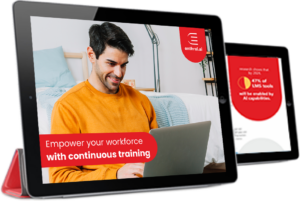Microlearning: A Game-Changer in Upskilling

At a time when learners are busier than ever, and any additional tasks can only overwhelm them, L&D teams can turn to strategies like Microlearning to create more engaging upskilling.
Microlearning is all about delivering small, crisp and targeted training modules to efficiently achieve learning objectives. These resources in digestible formats can easily be accessed through various media platforms and best cater to learners’ on-the-go needs.
In this blog, we look at microlearning, its impactful role in upskilling and tips for successful implementation through the learning platforms within your organization.
What is Microlearning?
Microlearning, as the name suggests, consists of brief and concise learning modules. Typically, these modules are under 10 minutes, and sometimes as short as three to six minutes, created to achieve specific learning outcomes. Presented in rich media formats, microlearning is a learner-centric approach that provides on-demand learning and upskilling, accessible on any device.
It draws heavily from the theory of human memory proposed by German psychologist Hermann Ebbinghaus. Through his Forgetting Curve, Ebbinghaus has showed that individuals commonly forget 80% of the information they acquire within a month. When they receive substantial amounts of information, they retain it temporarily. Yet, if this information is not deemed ‘essential’ to current tasks, it often diminishes over time.
To address this issue, a microlearning approach can be employed. Breaking down content into smaller segments and revisiting different parts over time can enhance knowledge retention and effectiveness.
Choosing Microlearning for L&D
In contrast to conventional training, microlearning is a smarter alternative that provides several advantages to modern learners. It significantly enhances on-the-job training as employees can acquire knowledge in a brief timeframe, seamlessly fitting into their daily tasks.
When incorporating microlearning into their upskilling strategy, L&D teams must ensure that they harness the essence of Ebbinghaus’s theory. The idea is to capitalize on microlearning’s “little and often” approach by providing learners with brief, easily digestible pieces of information that they are more likely to retain through regular revisits.
Moreover, learners also prefer to access training courses on their mobile devices while they are travelling or at the moment of their need. To get the best uptake for learning, it is key that L&D teams take advantage of these windows of opportunities through microlearning. Learners can be offered small learning resources in various formats including video, audio, PPTs, interactive games, quizzes and even assessments.
Key Benefits of Microlearning
1. Speeds up Learning
Employee surveys consistently reveal that lack of time is the top reason for not engaging in workplace learning. Microlearning addresses this by providing quick, concise learning experiences.
Given the demands of everyday tasks, minimizing training time is advantageous. Employees can upskill efficiently, balancing learning with their busy schedules. Microlearning allows for learning tasks in manageable segments, minimizing time commitments and offering practical benefits that can be readily applied.
2. Improves Learner Engagement
Maintaining learner engagement in extended learning sessions can be challenging, even for people with excellent attention spans. However, when learners are aware that the learning or training will be brief, it becomes easier for them to remain attentive.
Many people are naturally inclined to engage with new information for shorter durations. Microlearning is tailored to this preference, ensuring that employees stay engaged.
3. Enhances Knowledge Retention
Repetition is known to aid in retaining information. Microlearning encourages self-directed learning, as brief learning activities can be conveniently incorporated into daily routines.
These regular reviews of learned content also help reinforce knowledge and memory, providing continuous training.
4. Facilitates On-the-Go Learning
Microlearning, with its short, manageable training sessions, seamlessly adapts to any device. Longer training courses can be burdensome for employees, thus, bringing interruptions. This may lead to loss of progress or difficulty recalling previous information, requiring backtracking before continuing.
Microlearning complements mobile learning, enabling on-the-go learning. Quick, easily digestible lessons effortlessly fit into hectic schedules, making learning feasible nearly anywhere, at any time.
5. Encourages Self-paced Learning
People have varied learning styles, and microlearning accommodates this diversity. Unlike rigid, structured learning programs, microlearning provides a flexible solution. Employees can learn at their preferred pace, whether it is for subjects they are good at or those they need more time to master.
If an employee wishes to revisit a particular piece of information, they need not disrupt the entire learning course. That specific piece of information can constitute the majority or entirety of the short training module.
6. Enables Personalized Learning
Traditional training courses may pose challenges for employees, as they often contain information that is not directly relevant to their roles. Microlearning addresses this by allowing custom learning paths through concise, relevant learning pieces that exclude unnecessary information.
It also recommends different learning resources for different roles, supporting adaptable and personalized learning journeys. Each microlearning module has a narrow focus on one specific topic, preventing employees from spending time searching through extensive courses to find the one or two sections that are relevant to them.

Empower your workforce with continuous training
- Employee Onboarding
- Employee Upskilling
- Compliance Training
Actionable Tips & Best Practices for Microlearning
If you have chosen to make microlearning a core element of your L&D strategy to upskill your learners, here are a few points to bear in mind:
1. Assess the Compatibility
Microlearning is certainly a valuable tool, but it is not universally suitable for all topics. Certain tasks have to be detailed and cannot be effectively conveyed within a brief segment, like a 10-minute window.
Also, specific tasks require hands-on or in-person instruction, an area that is not feasible to deliver in condensed formats. Nonetheless, microlearning can be an excellent supplementary training method in such cases.
2. Avoid Downsizing Existing Courses
While it is a good practice to see how best you can reuse your existing content, this doesn’t mean you should simply reduce the size of your existing courses. If you attempt to downsize and convert larger eLearning courses into smaller courses without checking the feasibility, you might create something far removed from a microlearning course.
The preferred approach is to select from the many one-minute and 10-minute microlearning solutions provided by content providers in the market which can be excellent alternatives to traditional long-form training.
3. Boost Learner Engagement with Content Variety
Employees typically allocate about 10 minutes to a microlearning session. It is important for L&D teams to leverage this brief window effectively to engage with them. The agility and accessibility of microlearning courses must be maximized, which also highlights the importance of selecting the right courses.
Opting for courses that guarantee learners derive maximum benefits from their training time is essential. Employing various content types that engage and maintain learners’ interest during the short course is a proven strategy. Short videos, in particular, are effective in stimulating engagement and accelerating learners’ progress.
4. Gamify your Microlearning Courses
By incorporating gamification mechanics and techniques, you can effectively transform your microlearning courses into engaging games.
This approach provides employees with a sense of achievement and satisfaction upon completing a goal, similar to completing a level in a game. For instance, you might reward digital badges once they complete a set of microlearning courses on a specific subject or showcase points and statuses within the company.
5. Use Small Videos
Microlearning inherently improves engagement, but you can take it a step further by integrating captivating elements such as videos and quizzes. Videos are particularly effective because they engage both visual and auditory senses, which naturally enhances viewer attention.
Ensure your videos are concise, in line with the brevity of your microlearning content. Shorter videos tend to be more engaging and stay in the memory for longer. However, ensure all relevant information is included within a suitable timeframe.
6. Reinforce Training
To enhance long-term retention, regular review of the learning materials is necessary. After a series of microlearning modules, incorporate tools that facilitate review of employee learning.
This might be in the form of a quiz following a sequence of segments or a slide featuring bullet points summarizing the main takeaways from the course. Alternatively, you might reference a previous learning module in subsequent ones. In any case, refreshing employees’ memories is important.
7. Offer On-Demand Access Across Devices
Microlearning’s appeal to employees stems from its flexibility. Learners aren’t confined to their machines during work hours to engage with the content. Therefore, it is vital to develop microlearning materials accessible across all devices, particularly smartphones and tablets.
Ensure there are no constraints hindering employees’ access to these resources whenever they have the opportunity. If access to microlearning courses is limited to work laptops and computers, it diminishes the benefits.
Wrapping Up
The advantages that microlearning offers for supporting L&D initiatives are immense. Its conversational approach makes it a more fitting choice for today’s professional landscape.
As L&D teams embrace microlearning, it is important to understand that it is not designed to replace all other training methods, but rather to complement those. Adopting a well-rounded approach that incorporates various methodologies ensures a more impactful learning experience for employees.











